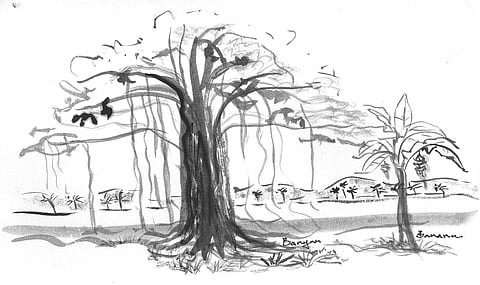
- LIFESTYLE
- FASHION
- FOOD
- ENTERTAINMENT
- EVENTS
- CULTURE
- VIDEOS
- WEB STORIES
- GALLERIES
- GADGETS
- CAR & BIKE
- SOCIETY
- TRAVEL
- NORTH EAST
- INDULGE CONNECT

Chennai’s canopy of trees is a quilted carpet of legends. Some of these trees are exotics. They have come from other lands and continents and planted themselves squarely within the cityscape. Others are temple trees dedicated to specific gods and goddesses. They are most often aromatic, bell-like, or trumpet-shaped, with an exact number of petals that lend themselves to be made into garlands. You find them signaling their importance from the courtyard of the temple next to an ancient stone-edged pool of water. Or discover their delicate blossoms in white and pink, scattered on the wet earth next to the sacred basil, or a Tulsi plant in its stone enclosure.
Tamarind tales
Some trees daubed with yellow turmeric and red kumkum dots have morphed into roadside temples. These remind you of the sacred groves that used to exist in Tamil Nadu. You still find one at DakshinaChitra, the museum of South Indian culture on the East Coast Road, presided by the terracotta guardians or Ayyanars that are said to have ritually patrolled the city’s precincts.
Other trees are like supermarkets. They lack the glamour of the exotics and don’t get the reverence given to the sacred ones. It could be a Neem tree (azadirachta indica). In the early morning you can sometimes catch a man chewing vigorously on a twig in his mouth and a cell phone in his hand. It’s called multitasking with a Neem tree toothbrush. Or the Tamarind tree with its feathery plumes and sweet-sour pods of tamarind that tempt young boys to throw stones at them. There is nothing quite so exotic as finding a raw tamarind pod, filling it with salt and chilli powder and eating it in summer. “If you want your husband to return soon from his travels abroad, let him sleep under a Tamarind tree at night,” advised a soothsayer, “when he falls sick ask him to sleep under a Neem tree. He will come back cured.”
These are most often the native species of trees, particularly the palm trees that rise out of the landscape with their jagged crown of serrated leaves. They provide innumerable uses, both culinary and commercial. The Palmyra Palm is the State Tree of Tamil Nadu.
Legend of the palm
The Traveller’s Palm (ravenala madagascariensis) as its name suggests came from Madagascar. It was planted at the entrance to many of the garden houses surrounded by acres of gardens during the Raj. The most spectacular display is at the front of the Horticultural Society of Chennai, near Gemini Circle. The semi-circle of palms with shaped leaves greets the visitors like bharatanatyam dancers flexing their knees to show off their pleated skirts. Legend has it that when you are really thirsty you can hack at the long spine of the Traveller’s Palm and drink from it.
Baobab, I like to travel
The Baobab (adansonia suarezensis) also came via Madagascar from Central Africa. According to its origin story, the Baobab was so fond of traveling the Devil decided to teach the Baobab a lesson. He planted it upside down. It’s roots seem to sprout at the top of a bloated trunk. They bring to mind a Justin Bieber haircut that has become the rage with a certain type of young man. If you visit the Golconda Fort in Hyderabad, the touts will point out a Baobab tree that was carved into a room near the walls of a fort by a spy. He used it to betray the fort to the kingdom’s enemies.
Stems of flavour
Some trees like the cleft-footed leaves of the bauhinia species, called mandara in Tamil, are used by cooks for baking, steaming, or merely lending a delicate flavour. Bamboo stems are used for steaming rice cakes. The leaves of the ginger plant, or banana, or colocasia, or of pandan impart subtle tinges of colour and flavour to a dish.
At the centre of the tree landscape of the city, stands the Grand Banyan at the Theosophical Society at Adyar. Discovered by Annie Besant herself, it has nurtured poets and philosophers, dancers and musicians as well as a multitude of living species that roost under its shade. It’s the guardian spirit of Chennai celebrating the city’s rich diversity.